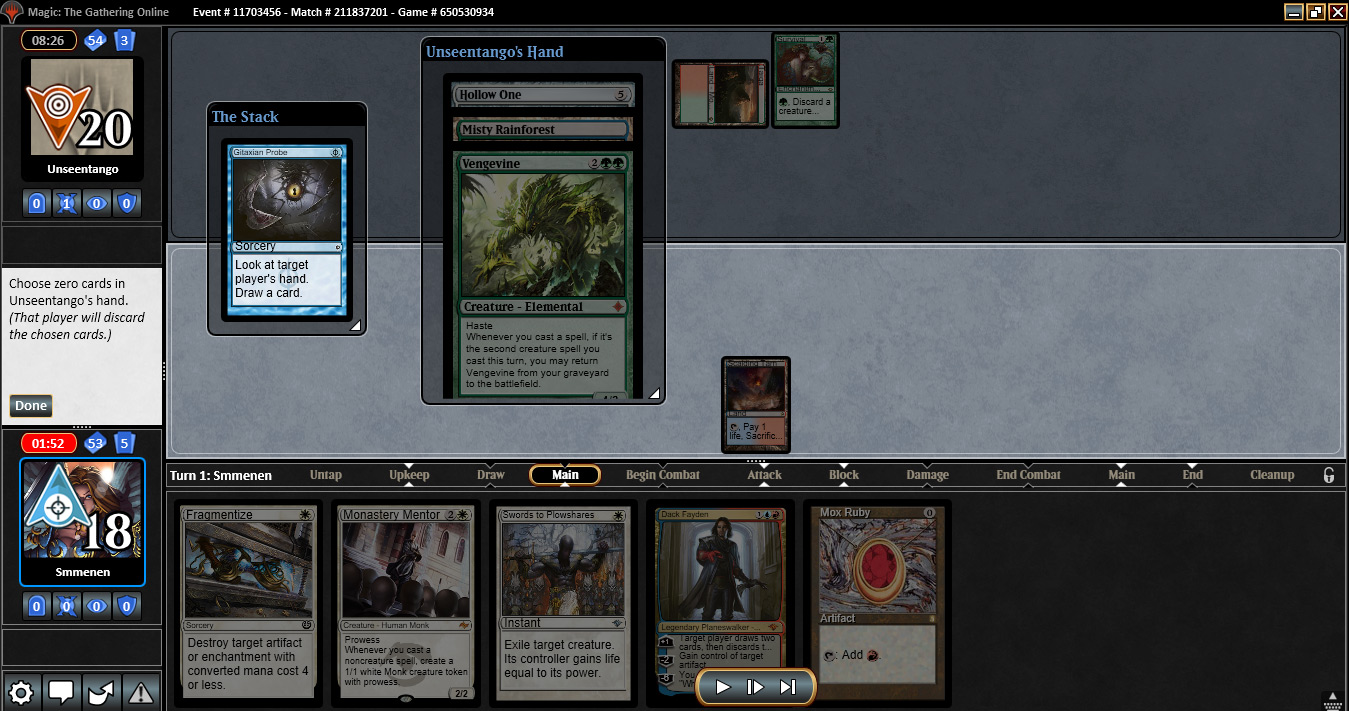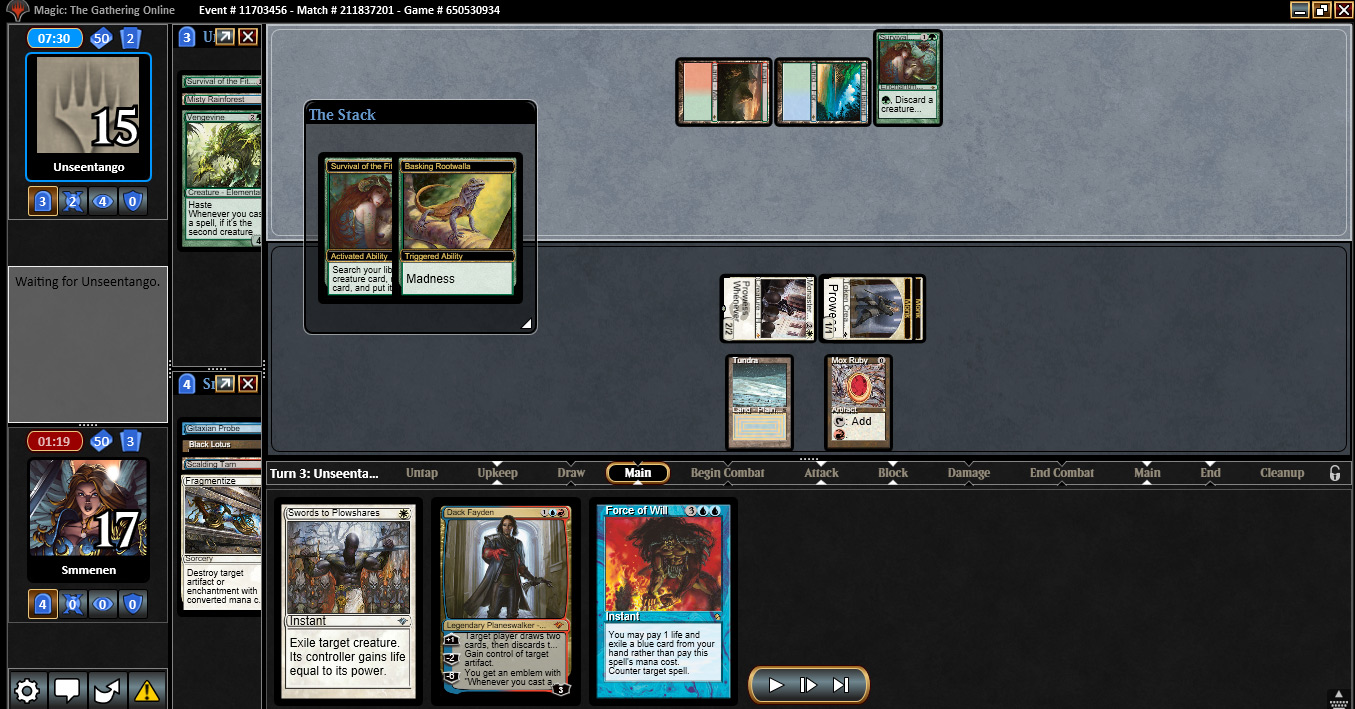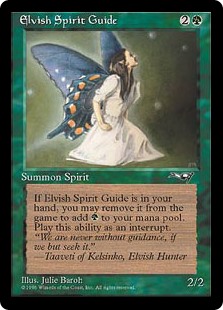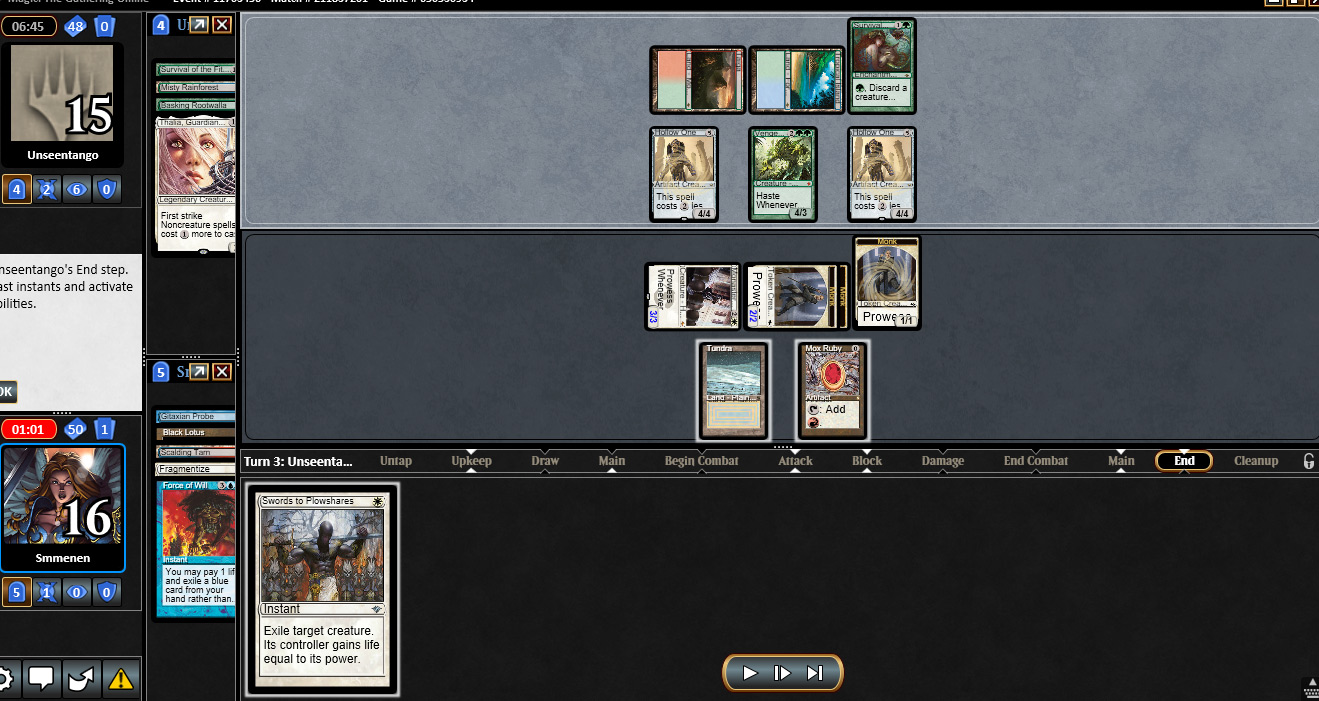Vintage is an amazing format. As much as I enjoy Old School formats, nothing reaches the same heights for me as a great game of Vintage. Vintage brings a mixture of elements that exist elsewhere, but so far as I can tell, not in this combination or with the same degree of intensity. They include:
1) High stakes decision making: Vintage is a big play format, in multiple senses. It not only has flashy, big plays, but it also has momentous plays with enormous consequences for the game and match. A single miscue or minor error can be fatal.
2) Complexity of the decision making tree: Old School Magic features some good lines of play, and strategy, but nowhere near the same level as Vintage, where long chains of plays can be drawn up many turns in advance, with one decision leading to another decision point. I doubt that there is another format with nearly the sheer quantity of branching lines of play as Vintage. And to add to that, each branch presents so many difficult decisions that have collateral effects. The quantity of tutors or quasi-tutors in the format, like Vampiric Tutor or Merchant Scroll or Dig Through Time, just create more lines of play than other formats can offer.
3) On-board operational complexity: this may actually just be an element that exists nowhere else to this degree. The operational complexity of Vintage is simply astounding right now. In terms of on-board operations, the current Vintage format may be the most complex ever, as players interface multiple planeswalkers, Ballista/Ravager/Steel Overseer, Survival, and Dredge, just to name a few. Just going through a single turn with a Dack and Jace (VP or TMS) in play involves multiple complex operations which interface and interact with each other. Getting each right requires computing a large number of variables simultaneously.
4) Tactical options: well, this is just a fact, since Vintage has the deepest possible card pool, it also has the largest possible pool of answers, like Leyline of Singularity as an answer to Flash, or Tariff as an answer to Archon of Valor’s Reach (naming Instant). There are more tactical options than anywhere else in Magic.
The heyday of Vintage, in my opinion, in terms of branching line play or strategic complexity was the Gifts Ungiven era, where decks like TPS and Gifts were some of the best decks, and each was enormously complicated to pilot, presenting novel situations regularly. I think the current iteration of Vintage is the closest to that we’ve had in some time. I am particularly enjoying the current crop of Xerox decks, which have been so hampered and humbled by restrictions that they can no longer consistently overpower opponents, but require skillful metagaming, strategic positioning, and great sideboarding and matchup understanding and preparation.
The layers and depth of play in the format are so enormous that it’s sometimes difficult to fully appreciate, let alone completely grasp. The lenses we have – like card advantage or tempo – are just a partial glimpse of reality. They can explain only a piece of a game, but not its beautiful totality. Not the gorgeous whole.
One of my favorite matches of all time in Vintage was a Jeskai Mirror match between Luis Scott-Vargas and Eric Froehlich in the Vintage Super League in 2016. The two-game match lasted a total of 17 turns per player, but what is so remarkable about it is how brilliant the play was at the speed with which it was played. There is no way that either player could have possibly fully thought through every play, but they brought their deep experience and powerful intuition to bear and made hyper aggressive plays in what was essentially the best game of Blitz Vintage I have ever seen. As Paul Rietzl said in his commentary, “these guys are playing at Warp 9.8 – Are they actually thinking about what’s going on, or do they just know intuitively what to do at all times?”
It’s a tragedy we don’t have more deep analysis of the branching lines and hinge points of Vintage games, as this is possibly the most fascinating element of the format. The sheer numbers of options at every turn in the game between Efro and LSV is mathematically astounding.
The quantity of options, the branching lines of play, and the high stakes decision making are all prominent features of the current Vintage format. I encounter them regularly in my Vintage game play. At some future point, I’d like to do more in-game analysis of this sort, taking a deep dive into a complex match like the one I linked above, but I am doing my best to try to finalize the revisions to the History of Vintage book, which accounts for all of my spare writing time at the moment. In the meantime, I thought I’d share a brief game that is well worth a look.
On November 17, I enrolled in the Vintage Challenge on Magic Online to play with this iteration of Jeskai Mentor, which I’ve been toying with for some time now:
Jeskai Mentor, by Stephen Menendian
| Business (38) 3 Dack Fayden 4 Jace, Vryn’s Prodigy 1 Monastery Mentor 1 Balance 2 Fragmentize 1 Gitaxian Probe 1 Merchant Scroll 1 Ponder 4 Preordain 1 Time Walk 1 Treasure Cruise 1 Ancestral Recall 1 Brainstorm 1 Dig Through Time 4 Force of Will 1 Gush 4 Mental Misstep 1 Mystical Tutor 2 Pyroblast 1 Spell Pierce 2 Swords to Plowshares Mana Sources (22) 1 Black Lotus 1 Mox Emerald 1 Mox Jet 1 Mox Pearl 1 Mox Ruby 1 Mox Sapphire 1 Arid Mesa 3 Flooded Strand 1 Island 1 Library of Alexandria 1 Mountain 1 Plains 3 Scalding Tarn 1 Strip Mine 2 Tundra 2 Volcanic Island | Sideboard (15) 2 Fragmentize 2 Pyroblast 3 By Force 1 Pithing Needle 1 Pyroclasm 3 Ravenous Trap 1 Subterranean Tremors 2 Tormod’s Crypt |
I won my first round against Workshop Ravager Aggro fairly quickly, and had a long wait for the second round.
In the second round, I was paired up against a Survival deck, piloted by “Unseentango.” In the first game, I was given a glacially slow and reactive hand. It seemed good against most matchups, but had almost no ‘action,’ card draw, or celerity. Unfortunately, my opponent had a similarly slow draw, and we both sat their pecking at each other for far too long, before I eventually lost. The frustrating thing about games like that is the outcome is simply too uncertain to scoop earlier, and thus neither of us did. But we ate up a large amount of clock in doing so.
In the second game, things were much more interesting, but my opponent put me in a very difficult position. A late game Balance saved me with about 5 minutes on my clock, but it still took me a while to win the game. My opponent refused to scoop (since I was the one using up most of the time trying to execute my end game), and so by the end of the game, I had eaten up all but about 2 minutes of my game clock.
That left us with a game 3 I had to win in under 2 minutes. Extremely unlikely, but not quite impossible. If I drew a quick Mentor hand, I could, theoretically, win the game.
My hand of 7 was the wrong mixture of mana and spells, and not enough of the former, with just one land, a Volcanic Island, Swords, Balance, and no cantrips.
I mulligan to 6, and see this hand:

Mentor, Frag, Ruby, Probe, Dack, and Plow
The merits were obvious. I drew the Monastery Mentor, and a Mox, which meant that if I drew right, I could land turn 2 Mentor. If I wanted to have a chance to win this game, I’d need to scry up a land, and I’d have a darn good chance. Failing that, the Gitaxian Probe gives me another shot.
I had no time to think about it more carefully, and a 5 card hand seemed like an even longer shot, so I decided to keep this hand.
After keeping the 6 card hand, I scryed, and left a Scalding Tarn on top of the deck.
The game begins.
Turn 1:
My opponent plays a Taiga, exiles Elvish Spirit Guide, and casts Survival of the Fittest. Annoying, but not a huge problem with Fragmentize in hand.
I draw Tarn for the turn. Here I confront my first meaningful game decision: I can play Fragmentize immediately, and pass the turn. Or I can cast Gitaxian Probe first, to see what I’m dealing with, on the off chance it changes my decision. The main reason to hold the Probe is to hope to play it once Mentor is in play, to generate more tokens and prowess.
I decide to Probe. I see Vengevine, Hollow One, and Misty Rainforest.

This means Survival is very strong with what they already have in hand, and makes destroying it with Fragmentize the priority.
But, wonder of wonders, I draw Black Lotus off of the Probe. This makes the rest of my turn easy. I play Lotus, cast Mentor, play the Tarn, and find Tundra, and cast Fragmentize. I cast Mox Ruby, and pass the turn with Mentor and two Monk tokens in play now. I’ve got 1:23 on my clock.
Turn 2:
My opponent drops a second land, fetches out Tropical Island, and casts what must have been a freshly drawn Survival of the Fittest! This could be a problem, but it will be a race.
Years ago, Survival of the Fittest was one of the most powerful tactics in the format. Folks might not remember this, but there were Survival decks in the 2003 Type I championship, and one of them was a finalist. And then it lived on for a while in Workshop decks called TnT or “Tools N Tubbies.”
Survival is an enormously powerful enchantment, and banned in Legacy. And it’s arguably more powerful than ever. The Legacy Survival deck had Basking Rootwalla and Vengevine as the core engine. But now, armed with Hollow One, this deck is truly monstrous.
The play pattern usually involves these three cards. The main line is to dump as many Vengevines in the graveyard as possible, then cycle through one or two Rootwallas, and hoping to cast a free Hollow One, which then triggers the Vengevines to come into play for a deadly assault.
But that’s often not the best route. You might, for example, want to get Squee, Goblin Nabob for the long game, or search up Anger or Wonder for additional speed or evasion. Survival presents many options, with the only limiting factor often being access to green mana.
Unless my opponent drew a land this turn, or another land next turn, they’ll only be able to Survival twice. So, the ideal draws for them on Turn 2 and Turn 3 might be a creature (any creature), and another land drop (or green mana producer).
On my second turn, I draw Force of Will. I’m now holding Dack Fayden, Force of Will, and Swords to Plowshares. I am one mana shy from casting Dack, so all I can do – for now – is attack with Mentor and 2 Monk tokens, sending Unseentango to 15 life.
1:21 on my clock – a two-second turn.
Turn 3:
The opponent begins their turn and starts the Survival chain, activating Survival, binning Vengevine, and searching up Basking Rootwalla. They then activate Survival again, discarding Rootwalla (the Madness trigger puts the Rootwalla on the stack, with the second Survival activation beneath that). Here’s the game state at this point:

This is the first spell my opponent cast this turn. I know they have Hollow One in hand, and a mystery card. Unless they have a land drop, it’s hard for me to see how they might cast Hollow One this turn. There was just one thing I forgot to account for, which you may have already thought about. But before I get to that, let’s go over the problem confronting me, as I understood it, more carefully.
The decision matrix I was confronting had two steps: 1) is Rootwalla worth countering on its own merits? And 2) If so, is it worth pitching Dack to do so?
This simple two-step problem just begins to illustrate the latent complexity of Vintage. Let’s consider both, separately.
My board has Mentor and 2 Monk tokens. If I counter the Rootwalla, not only do I create another Monk token, but if I draw a spell I can cast, like a Mox or a Preordain next turn, I can potentially Plow the “sick” newly created Monk, and attack for more damage (3 potential 3/3 Monks, and a potential4/4 Mentor). On the other hand, if I let Rootwalla resolve, I can just Plow it directly on my turn anyway, clear out the blocker, and still attack (2 2/2 Monks, and 1 3/3 Mentor), and possibly more damage if I draw a spell that I can cast. The Plow will gain him a life, and may actually allow him to live. So if I do not Force of Will it may actually give him more turns.
The Plow seems like the sounder play, but it dramatically reduces my chances of just winning the game on my next turn. But either play seems reasonable, and is defensible, in its totality. But what about countering the Rootwalla on its own merits? It clears a blocker while it also creates another Monk tokenI can pump, and does not gain him any life.
The downsides are that I lose Dack, and won’t be able to counter anything else this turn, or possibly the rest of the game, while definitely weakening myself for a longer game, one that has a more definitive chance of victory with Dack, if – and it’s a big if – I draw another mana source next turn.
To see this, let’s consider the second question now, which is more speculative. If I draw a mana source, I can play Dack, which will pump up the Mentor and Monks, and allow me to turn on the gas the following turn, or would potentially allow me to steal their Hollow One if they are able to cast it. But that’s a two turn clock, instead of possibly just winning next turn.
Now, think about all of that reasoning, and factor in one other element: at the moment I’m confronted with this decision, I have 79 seconds left on my clock! This makes the “two more turn” long game play even more speculative and perilous, and the tempo play more attractive, of just trying to win next turn.
I ended up casting Force of Will on the Basking Rootwalla, pitching Dack. Would I have made this play if I had three minutes on my clock? Probably not. But, I might not have kept a no-land hand if I had 5 minutes, either. I needed to give myself the best chance to win in under a minute, in order to win the match.
Now the kicker: all of this happened with a Survival activation on the stack. Because of the way Madness works, I had to decide to Force before they revealed the Survival target. And this was the variable I should have considered more carefully:

They found this critter, and exiled it to make a green mana, and then discarded a Thalia (the card drawn for the turn), and then found another Hollow One. Ouch.
This solved multiple problems. They could now cast the Hollow One in hand, and another for good measure. Survival is so powerful, it can literally find a mana source, despite not officially saying so. Oh, and the Vengevine triggered from the graveyard, and entered play. Perhaps sensing my weakness to my own clock, they adopted a more defensive stance, and decided not to attack me, and passed the turn back to me.
Here’s the board at the end of their third turn:

Now, not only have I lost Force and Dack, but they have three blockers in play. Sure, I can Plow one, but even if I draw another spell, it’s as big as my Mentor.
Whatever my chances of winning were, they just fell precipitously. This result made my Force line look quite underwhelming. The Dack could have given me the leverage I needed to win a longer game, generating Monk tokens to fend off a counter attack, while eventually building a bigger army. If I had more time, and could cast Dack next turn, I could hold off an entire army. They didn’t even have any cards in hand either, so they’d need to draw a creature.
There was nothing I could do but sigh, and take my next turn.
Turn 4:
I drew a Preordain for the turn. Now, I am confronted with yet another interesting choice. I have to decide whether to Preordain, and hope to find another Tundra, or just Plow one of their creatures immediately.
If I Preordain into a Tundra or fetchland, and then Plow one of their creatures, I could attack with the Mentor and the Monk tokens for 13. They could block the Mentor and a Monk and take just 6, but will lose another creature.
If I just Plow a creature, and they don’t find another creature next turn, then I can jump start the sequence with the potential to go lethal the following turn. But if they find another creature, they will be able to put more Vengevines in the graveyard, and deploy them the following turn.
The Plow doesn’t seem to do much by itself, while the Preordain is hugely significant.
If I had held the Force, I could have Forced one of the Hollow ones, or tried to draw a land and then stolen one of them with Dack Fayden, which is even better.
I cast Preordain, seeing Pyroclasm and Force of Will. Awkward. I bottom both and draw Flooded Strand.
Unfortunately, I’ve just got 42 seconds left. Not really enough time to think anything through. I fetch out a Tundra, and Swords to Plowshares a Hollow One, and blindly attack with a 4/4 Mentor and 3 3/3 Monk tokens, now with two more newly minted ones in reserve. Vengevine blocks Mentor to trade, and the remaining Hollow One slays a Monk. My opponent takes 6 and falls to 9.
I am now down to 36 seconds, with just 4 Monk tokens left, and pass the turn back.
Turn 5:
My opponent draws a creature, but decides not to use Survival at all. They must calculate that with only 30 or so seconds left, it will be hard for me to win on board, so they cast the freshly drawn Deathrite Shaman, rather than attempt to chain more Basking Rootwallas.
I untap and draw Scalding Tarn, and pass.
Turn 6:
The opponent draws for the turn, and then activates Survival (pitching Squee!), finding a Vengevine, which they discarded for a Rootwalla. They then use the Deathrite to remove a land and generate a mana to discard the Rootwalla to Survival again, finding another Hollow One, which they cast. The Rootwalla and Hollow One triggered both Vengevines from the graveyard, and the opponent once again holds back in a defensive posture and passes back to me.
I drew a Mox Emerald on my turn, and scooped with 22 seconds left on my game clock.
There is no doubt I could have done things differently to play better. Forcing the Rootwalla was my biggest mistake, but I didn’t see the play of using Survival for Elvish Spirit Guide, so I didn’t see the danger I faced. Given the enormous time pressure I was facing, I thought I played pretty well overall. My mulligan decision was counter-intuitive, but strong. I sequenced the Preordain correctly. I probably should have Plowed Vengevine instead of Hollow One, but that was not an egregious error.
This one 90 second game illustrates the complexity embedded in a game of Vintage. There are so many decisions, and each decision matters. It shapes the flow and outcome of the game, often in dispositive ways. I overlooked one fact, and made a fatal miscalculation. And each player had not only tactical decision to make, but strategic ones. Their decision to play the Deathrite Shaman proved well-founded, and the Survival chains were well considered.
You should have seen the other games!
Until next time,
Stephen Menendian

